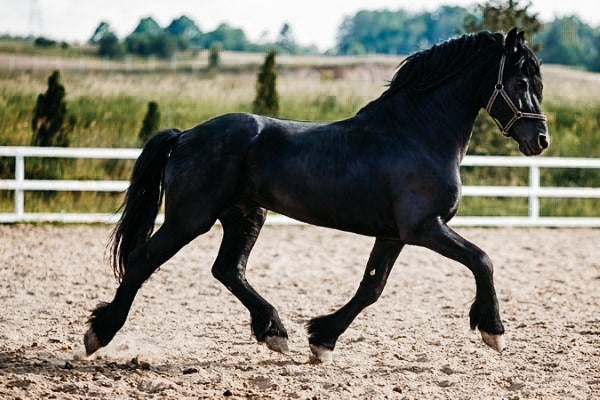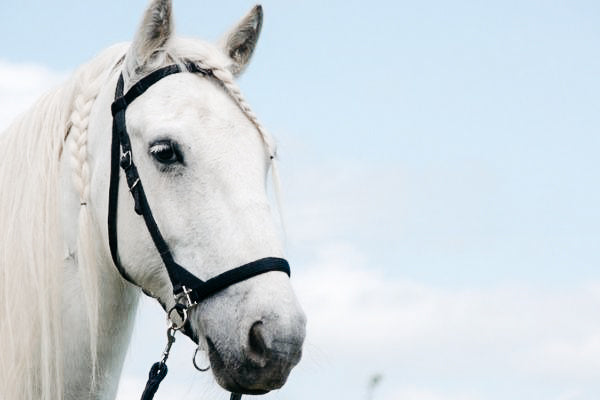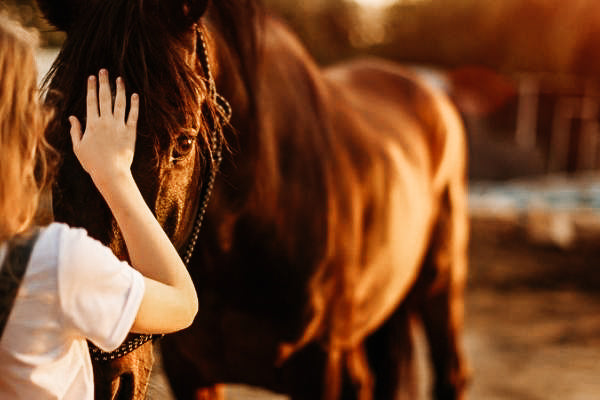
Friese – the versatile, impressive black horses
Of all horse breeds, the Friesian is a horse that particularly stands out due to its impressive appearance. These noble animals were popular at the beginning of the 20th century. In the 19th century they were still threatened with extinction, but today they are very popular leisure or dressage horses and are often used in horse shows.
They are also very suitable for pulling a carriage and cause admiration with their impressive exterior and lively gaits.
These baroque horses are striking because of their lush long hair with a full, usually slightly wavy mane and a long tail, as well as the clear tail.
Breed-typical coat color
As is typical of the breed, the Friesian is a black horse, but shades can certainly occur. Traditionally, however, no markings are desired; the coat of the Friesian horses should be shiny black throughout. A mare is allowed to have a star as a badge, but larger badges are not wanted.
A white Friesian is not a purebred Friesian, the white Friesian stallion Nero from Gut Dankerode is an Arabian-Friesian mix and can therefore show the color that is atypical for this horse breed.
Friesian horses have a dry head with no gaps, a harmonious physique with a medium-long, well-muscled neck, a sloping shoulder and prominent withers and are therefore also suitable as dressage horses.
Their character is strong-nerved and uncomplicated; their strength and gentleness make them excellent carriage horses. Mares usually reach a height of 155 to 165 centimeters, the stallions usually grow taller. Horses of this breed are called baroque horses because of their body type.
Friesians and their breeding
The breeding history of this Dutch horse breed began in the 16th century. century This makes the Friesian horse one of the oldest horse breeds in Europe.
The Spanish occupied the Netherlands and brought their Iberian horses with them. A rather cold-blooded native horse type was crossed with the Iberians in the province of Friesland and this is how the horse breed known today was formed.
At the beginning of the 18th century In the 19th century they were used as carriage horses for light, elegant carriages in stately homes. However, demand for baroque horses declined, so that in 1913 there were only three Friesian stallions left.
Committed breeders stood up for the black horses and stopped the supply of blood from other breeds. So the stud book founded in 1879 was closed and the Friesian was bred purely. This had the disadvantage that inbreeding had to be carried out due to the low population. Nowadays, every Friesian horse registered in the Dutch studbook is determined to have a so-called inbreeding factor. From this you can see what percentage of inbreeding the horse's genome is burdened with.
A white Friesian was created in the 1970s when a new breeding line was created through cross-breeding with Arabians, namely the Arabo Friesian, to which Nero also belongs.
Approval
The licensing of a Friesian stallion is carried out according to very strict criteria. During the difficult test, in addition to the exterior and gait, the interior is also evaluated, such as the stallion's willingness to work or its behavior in the stable.
Even if the stallion has successfully completed this test, he has to face the jury again every year. The final assessment only takes place when the first crop of foals are three years old after four or five years.
Today the impressive black horse is represented in over 50 countries, and the oldest horse family book in the Netherlands contains 60.000 registered horses. Thanks to the efforts of committed breeders, this horse breed, which is part of the Dutch cultural heritage, was saved.
Animalons brush recommendation for the Friesian:
The Friesian's magnificent mane and long tail require special care to look as smooth as possible. Our handy mane and tail brush untangles the horse's hair easily and also cares for it very gently.
Even the smallest speck of dust is visible on the Frisian's black fur. That's why we recommend our Care Flex Shine Brush made of goat hair, which both removes loose dust from the coat and creates a beautiful shine on the horse's fur.
Discover more posts

Bitless bridle - great freedom for the horse's mouth
It's hard to believe, but domesticated horses have actually had a kind of gag in their mouths since before Christ. This was antler horn or even animal bones, which people at that time processe...
Continue reading
Natural Horsemanship – an attitude that every horse understands
Everyone has heard of it: Natural Horsemanship. Since Pat Parelli's relevant publications, the hype with the waving rope has never stopped. In fact, it's much more than swinging a stick. ...
Continue reading
